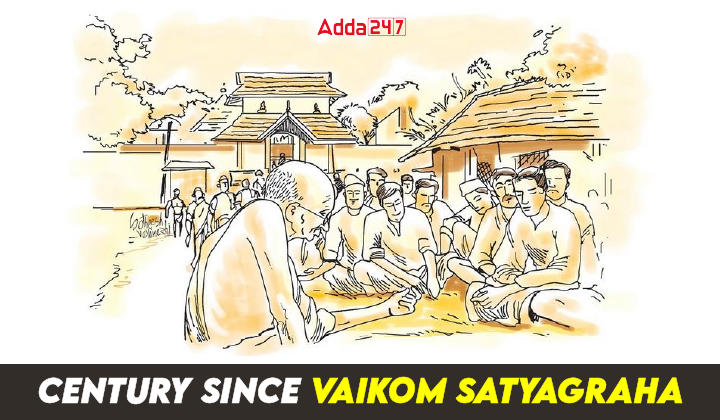Table of Contents
In the serene temple town of Vaikom in the princely state of Travancore, a pivotal movement began on March 30, 1924, which would etch itself in the annals of Indian history for pioneering social reform amidst the burgeoning national movement. Known as the Vaikom Satyagraha, this non-violent agitation brought to the forefront the pressing issues of untouchability and caste discrimination, marking a significant step towards social equality.
Vaikom Satyagraha Unfolds
In a strategic move, leaders like Madhavan chose to initially target access to the roads encircling the temple, rather than the temple itself, for the avarnas. On the morning of March 30, 1924, a diverse trio comprising a Nair, an Ezhava, and a Pulaya, adorned in Khaddar and accompanied by a large following, made their way towards these roads but were swiftly detained.
This pattern of peaceful defiance continued, with new participants stepping in daily to challenge the restrictions, until the authorities responded by sealing off the area on April 10, effectively halting arrests but also escalating the situation.
Protesters, undeterred, maintained their vigil at the barricades for months, engaging in fasts and patriotic singing. Esteemed figures like Periyar and C Rajagopalachari lent their support on the ground, amidst ongoing confrontations and hostility from those opposing the movement.
The dynamic shifted in August 1924 with the passing of the Maharaja of Travancore. His successor, Queen Sethulakshmi Bai, ordered the release of all detainees. However, her refusal to grant universal temple access led to continued tensions.
A significant breakthrough came in March 1925 when Gandhi negotiated a partial victory: three of the four disputed roads were opened to all, excluding one that remained exclusive to Brahmins. This compromise was enacted in November 1925, following the construction of alternative routes for the lower castes. This marked the conclusion of the Vaikom Satyagraha, with the final participant withdrawing on November 23, 1925.
Travancore’s Social Milieu in the Early 20th Century
Travancore’s societal structure was deeply entrenched in rigid caste norms, where the notion of purity extended from touch to visibility, barring lower castes from sacred spaces. This period, however, also witnessed significant upheavals. The advent of Christian missionaries offering an escape from caste subjugation through conversion and progressive reforms initiated by Maharaja Ayilyam Thirunal Rama Varma catalyzed a wave of change. An emerging educated elite among lower castes, particularly the Ezhavas, began to challenge the status quo, despite persistent barriers in employment and societal acceptance.
The Prelude to Satyagraha
The clamor for temple entry first resonated in the writings of Ezhava leader T K Madhavan, who, inspired by Gandhi’s Non-Cooperation Movement, sought more direct action. Despite facing stiff resistance and a lack of royal support for reforms, the involvement of the Indian National Congress in 1921, bolstered by Gandhi’s backing, set the stage for a concerted anti-untouchability campaign, culminating in the selection of Vaikom for a landmark Satyagraha.
The Unfolding of Vaikom Satyagraha
The initial focus was on the roads surrounding the Vaikom temple. The daily ritual of satyagrahis attempting access and courting arrest soon led to a significant standoff, with protests persisting in the face of police barricades and upper-caste antagonism. The intervention of national leaders like Periyar and C Rajagopalachari amplified the movement’s resonance. Despite a temporary respite following the Maharaja’s demise in 1924, the struggle encountered royal reluctance to grant unrestricted temple access.
A compromise mediated by Gandhi in 1925 partially opened the temple roads to all, barring one, thus concluding the Satyagraha with a nuanced victory. This compromise, while strategic, left many, including Periyar, disenchanted with the partial fulfillment of their aspirations.
The Legacy of Vaikom Satyagraha
The Vaikom Satyagraha stands out as an extraordinary chapter in the annals of social reform, enduring over 600 days against a backdrop of societal hostility, authoritative clampdowns, and natural calamities like the catastrophic flood of 1924. Its success lay not just in its perseverance but in fostering unprecedented solidarity across different castes, essential for the movement’s sustained momentum.
The real turning point came in November 1936, when the Temple Entry Proclamation was enacted by the Maharaja of Travancore, dismantling the longstanding barriers that kept marginalized castes out of state temples. This monumental decree, coupled with the effective showcase of nonviolent resistance as championed by Gandhi, cemented the Vaikom Satyagraha’s place as a pivotal movement for social justice. It boldly confronted the deeply entrenched issues of untouchability and caste discrimination, setting a precedent for future struggles for equality across India.



 TSPSC Group 1 Question Paper 2024, Downl...
TSPSC Group 1 Question Paper 2024, Downl...
 TSPSC Group 1 Answer key 2024 Out, Downl...
TSPSC Group 1 Answer key 2024 Out, Downl...
 UPSC Prelims 2024 Question Paper, Downlo...
UPSC Prelims 2024 Question Paper, Downlo...
